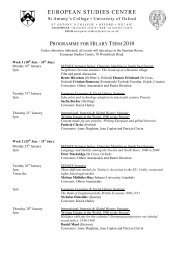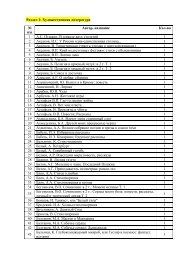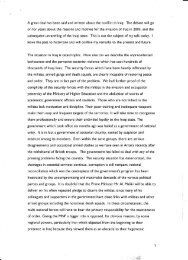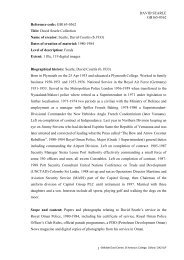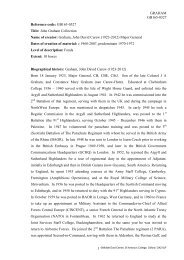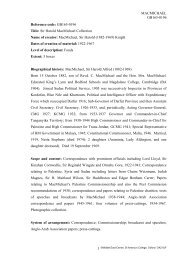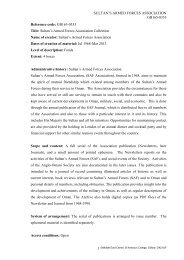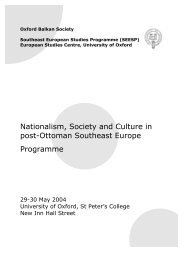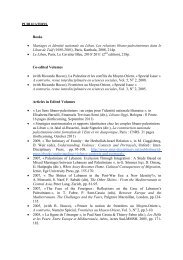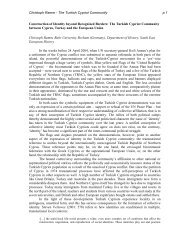Managing Migration: The Global Challenge, Population Bulletin, Vol ...
Managing Migration: The Global Challenge, Population Bulletin, Vol ...
Managing Migration: The Global Challenge, Population Bulletin, Vol ...
You also want an ePaper? Increase the reach of your titles
YUMPU automatically turns print PDFs into web optimized ePapers that Google loves.
<strong>Managing</strong> <strong>Migration</strong>: <strong>The</strong> <strong>Global</strong> <strong>Challenge</strong><br />
<strong>Managing</strong> <strong>Migration</strong>:<br />
<strong>The</strong> <strong>Global</strong> <strong>Challenge</strong><br />
by Philip Martin and Gottfried Zürcher<br />
<strong>The</strong> number of international migrants is at an all-time<br />
high. <strong>The</strong>re were 191 million migrants in 2005, which<br />
means that 3 percent of the world’s people left their country<br />
of birth or citizenship for a year or more. 1 <strong>The</strong> number<br />
of international migrants in industrialized countries<br />
more than doubled between 1985 and 2005, from almost<br />
55 million to 120 million.<br />
However, most of the world’s 6.6 billion people never<br />
cross a national border; most live and die near their place<br />
of birth. Those who cross national borders usually move<br />
to nearby countries, for example, from Mexico to the<br />
United States, or from Turkey to Germany. <strong>The</strong> largest<br />
flow of migrants is from less developed to more developed<br />
countries (see Figure 1). In 2005, 62 million migrants<br />
from developing countries moved to more developed<br />
countries, but almost as many migrants (61 million)<br />
moved from one developing country to another, such as<br />
from Indonesia to Malaysia. Large flows of people also<br />
move from one industrialized country to another, from<br />
Canada to the United States, for example, and much<br />
smaller flows move from more developed to less developed<br />
countries, such as people from Japan who work in<br />
or retire to Thailand.<br />
<strong>The</strong> international community believes that international<br />
migration should be voluntary, and has tried<br />
to minimize “forced migration,” whether motivated<br />
by persecution or economic deprivation at home. <strong>The</strong><br />
United Nation’s 1948 Universal Declaration of Human<br />
Rights asserts that “everyone has the right to leave any<br />
country, including his own, and to return to his country. 2<br />
However, the right to emigrate does not give migrants a<br />
right to immigrate, and most migrants are not welcomed<br />
unconditionally into the countries to which they move.<br />
<strong>Migration</strong> in Perspective<br />
<strong>Migration</strong> is the movement of people from one place<br />
to another. As long as humans have wandered in search<br />
of food, they have migrated from place to place. But<br />
international migration is a relatively recent development.<br />
Only in the early 20th century was the system of nationstates,<br />
passports, and visas developed to regulate the flow<br />
of people across borders. 3<br />
A Surinamese migrant worker assembles a bouquet at the world flower market<br />
in Aalsmeer, Netherlands.<br />
International migration is the exception, not the rule.<br />
Most people do not want to move away from family and<br />
friends. In addition, governments try to regulate border<br />
crossings. But international migration is likely to increase<br />
in the 21st century because of persistent demographic<br />
and economic inequalities and because many advances in<br />
communications and transportation facilitate mobility.<br />
Figure 1<br />
Origin and Destination of International Migrants, 2005<br />
Migrants from more developed countries<br />
To less developed countries <br />
To more developed countries<br />
Millions<br />
Migrants from less developed countries<br />
To less developed countries<br />
<br />
To more developed countries<br />
Millions<br />
Sources: United Nations (UN), Department of Economic and Social Affairs, <strong>Population</strong> Division,<br />
International <strong>Migration</strong> Report (2006); and UN, International <strong>Migration</strong> 2006 (Wall Chart).<br />
<br />
<br />
<br />
<br />
<br />
<br />
<br />
© Mark Henley/PANOS<br />
<strong>Population</strong> <strong>Bulletin</strong> <strong>Vol</strong>. 63, No. 1 2008 www.prb.org 3



